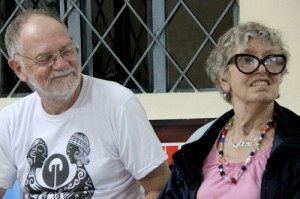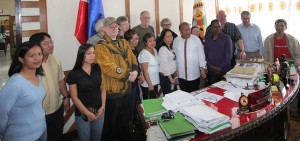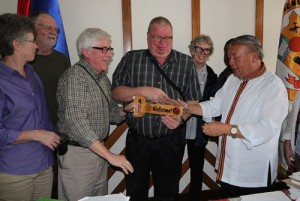My Cordillera Exposure
My Cordillera Exposure
Some observations on life in barangays
Bob McElhinney
Retired Minister, United Church of Canada

Rev. Bob McElhinney, pastor at the Downsview United Church, and wife Dorothy - in solidarity with the Cordillera people in the fight against destructive large-scale mining in the Cordillera.
As I prepared to return to Canada on April 17, I felt very grateful for the opportunity to be exposed to the beautiful Cordillera and its indigenous people. My wife Dorothy and I were part of the Beaconsfield Initiative, a United Church of Canada-sponsored group investigating the impact of large-scale mining on Indigenous People and on the environment (Jan.2-12).* I sought an opportunity for further exposure, and Dorothy flew home later in February. This I was able to arrange with the support of the Regional Ecumenical Council of the Cordilleras (RECCORD), the Cordillera Peoples‘ Alliance (CPA), and United Church of Christ in the Philippines (UCCP) pastors in Abra. The latter accompanied me, and thoroughly enjoyed initiating me into the many traditions and routines of barangay life.
My purpose here is to share some of my observations on community life in barangays, particularly from time spent in Sallapadan, Abra; Besao, Kalinga; and Ucab, Benguet. Further I wish to relate these observations to the impact of large-scale mining claims and operations.
Life in these Barangays, as I observed
While these communities strive to be self-sustaining, they are economically poor. Sallapadan and Besao rely on rice farming and their local animals (which live among them and roam freely). Both have just one planting of rice per year. This can result in shortage, and other means of employment are required. Some young men in Sallapadan travel good distances to work in small scale mining. Those in Besao sometimes get highway construction jobs at 200 pesos per day out of which they pay for their food and travel. Ucab is different, reliant on traditional small-scale mining, which is an extended family operation. It is also within commuting distance of Baguio, allowing some residents to work there, if they can find employment. People live without a social safety net like we have in Canada. Nor do they have government pension benefits, although some seniors can access a small amount from the national government.
Indigenous people have ancestral claim and therefore ownership of their land. They are free to take the wood they need from the forest to build their homes, which they do cooperatively. In Ud-udiao, Sallapadan, I saw a very large chainsaw which they haul up the mountain to fell the trees and cut them to the required size for building. Then they haul the lumber down. Housing in Sallapadan and Besao, while usually rudimentary and unadorned with paint or preservative, appears basic to resident’s needs. Usually there are no windows but wood slats to protect against the elements. The roofs, low pitched, are of corrugated tin (and in no danger of collapsing from any snowload). In Ucab – while this description is true for the majority – there is more diversity. Some houses are larger, have glass windows and other modern amenities. Often these barangays have craftsmen who produce very fine pieces of furniture.
A real strength of these communities is the functioning of the extended family. I was impressed by the interconnectedness of people. Second cousins abound! I was even named one by my faithful interpreter Muray in Sallapadan!

Members of the Beaconsfield Initiative at the Provincial Government offices with Benguet Governor Fongwan - (from right to left of the governor) Connie Sorio of Kairos and Stop the Killings in the Philippines Network in Canada, Tess Tessalona of Centre for Philippine Concerns, Beth Dollaga of Canada-Philippines Solidarity, and the author, Rev. Bob McElhinney (centre at back).
Threats to the life and health of these Barangays
The threats to the life and health of these barangays are far more external than internal. Elders (sometimes with the help of pastors) are called upon to mediate internal clan disputes.
The external threats are these:
• the ongoing conflict between the Government of the Philippines through its military arm the Armed Forces of the Philippines, and the New People’s Army. A peace process is presently on hold due to the incarceration of political prisoners, including Alan Jazmines, a negotiator in the peace process for the National Democratic Front of the Philippines. Armed conflict occurs, and civilians have been caught in the crossfire.
• it is clear that the growing number of large-scale mining claims (including Canadian) in the Cordillera has brought increased militarization. The national government is providing militia to large-scale mining companies, trained by the AFP.
• this militarization has meant encampment by the AFP in or near barangays e.g. Sallapadan Barrio Elementary School. This in turn has led to bribes or intimidation of citizens, sexual advances on women (in Mankayan an AFP officer was recently charged on two counts of rape of a minor).
• community organizers and pastors have been vilified and killed with impunity.
Ucab is a special situation – no less alienating for the community. Here the Benguet Mining Co. has been extracting gold since the 1930s. In the early 1990s the company began open-pit mining operations. The community rose up and barricaded the bulldozers. The company arranged for AFP reinforcements, but they were unable to stop the barricade. After a one-year standoff, the courts declared the open-pit mining practice illegal, and the company ceased all mining operations. However the company has continued to assert its ownership of the land and charges small-scale miners an operating fee, despite the ancestral right of these Indigenous People to their own land. Only the elderly in Ucab can remember a time before this struggle.
All of this is leading to widespread local opposition to large-scale mining and its unwelcome effects. Indigenous People – as people of the land – feel a special obligation to defend it, and are offended by environmental damage inflicted by the likes of Lepanto Mining and its pollution of the Abra river. Finally the Cordillera is a region regularly afflicted by natural disasters – typhoons, earthquakes. Large-scale mining further destabilizes this already vulnerable environment.

Benguet Provincial Governor Nestor Fongwan (right) welcomes visiting United Church Ministers (from left) Patricia Lisson, Bob McElhinney, Bill Phipps and Shaun Fryday.
CONCLUSION
Despite promises of employment and other community benefits by mining companies and GPh, it is no wonder that the great majority of the Cordillera people along with the organizations that have supported me in this exposure are strongly opposed to large-scale mining in the Cordillera. If we in Canada are to be part of the solution to this problem, we too must join the struggle. We must endeavor to get our own mining companies and our conservative federal government to understand what is at stake, beyond economic profits for the few. We can withdraw our investments in mining companies doing business in the Philippines. We can press our own organizations, as Beaconsfield Initiative is doing right now with our United Church of Canada, to stand against large scale mining in the Philippines, under present political and economic conditions.
Agyamanak to many, for this revealing exposure.
————————————–
* From January 2-12, 2012, fourteen Canadian delegates visited the Cordillera and Ilocos Regions in an exposure mission, the Beaconsfield Initiative, to evaluate the impact of Canadian mining interests in the Cordillera and its accompanying human rights issues.
At present, there are six Canadian mining companies with mining applications in indigenous peoples’ territories in the provinces of Benguet and Abra namely: Columbus/Magellan, Olympus Mining Company, Solfotara mining company, Pacific Metals Canada-Philippines, Adancex, and Canex. The 5th Infantry Division of the Armed Forces of the Philippines is deployed in the Cordillera and Abra is one of the most militarized provinces in the region. The 503rd Brigade is stationed in the province under the command of Col. Eliseo Posadas.




Comments (1)